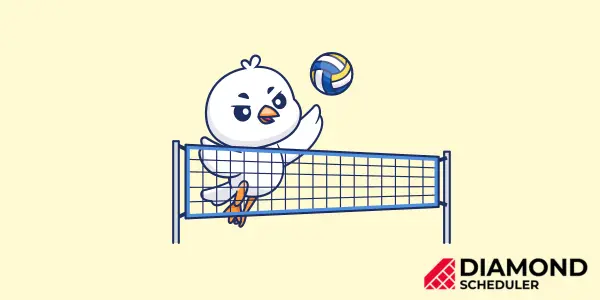
League Owner's Guide: How Many Sets Are In A Volleyball Game
Volleyball, with its adrenaline-pumping rallies and team-centric gameplay, is a hugely popular sport. Each volleyball team consists of six players squaring off against another six on the opponent's court. This fun game revolves around the concept of sets.
Each set represents a critical phase of the volleyball match, determining the number of points one team must score to walk away as the winning team. Determining how many sets are in a volleyball game depends largely on the type of volleyball game it is.
With this popular sport being played indoors, on the beach, and even seated, the number of sets typically played can vary greatly. One thing that doesn't change is that a volleyball game always has two teams, with the final set giving one team the win.
How many sets are in a volleyball game?
The number of sets in a volleyball game varies based on the level of play and the rules of the governing body. In most professional and international volleyball matches, the standard set structure typically involves a best-of-five sets format.
This means the winning team is the first to win three out of five sets. The introduction of a best-out-of-five-sets format has added an element of unpredictability to the volleyball game structure, as matches can swing in favor of either team until the final point is won.

What is the standard volleyball set structure?
The concept of a set in volleyball revolves around a predetermined number of points that a team must score to win in a particular phase of the match. To ensure a fair and competitive game, volleyball employs the rally scoring system, where points are awarded on every rally, regardless of which team served the ball.
A team can win a set when they score 25 points and maintain a two-point lead over the opposing team. If a team reaches 25 points while the opposing team has 24 points, the game continues until one team establishes a two-point advantage.
The overall match winner is determined by the total scores of all the sets played, allowing a team to potentially lose two sets but still win the entire match.
Traditionally, indoor volleyball sets are played to 25 points. However, recent years have witnessed variations in scoring, particularly in volleyball games played on the beach.
This type of volleyball match may be played to 21 points. This alteration in scoring has injected fresh excitement into the sport, with players and fans witnessing intense battles for every crucial point.
In a regular volleyball match, the first four sets are usually played to 25 points. If a tie-breaker set is needed (also known as the fifth set), it is played to 15 points. The shorter fifth set adds an element of pressure and challenges teams to maintain their composure in high-stakes situations.
Set structure in different volleyball contexts
Set structure in indoor volleyball
What's the difference between high school volleyball, college volleyball, and the professional leagues?
How many sets are played can vary depending on the level of competition. High school volleyball games often consist of three sets, making it a quicker and more accessible format for younger players.
This format allows high school players to gain valuable experience and develop their skills without the extended duration of a best-of-five sets match.
College and professional volleyball matches commonly adopt the best-of-five sets format, providing a more extended and demanding competition. The transition from high school to college volleyball introduces players to a higher level of intensity and competitiveness.
The additional sets bring more strategic gameplay and enhance the overall spectacle for fans, something that players may not have experienced playing volleyball in high school.
Both men's and women's teams generally play best-of-five sets, each playing to 25 points. However, certain leagues or competitions might have specific regulations that vary slightly.
The fundamental gameplay remains consistent, with each team aiming to win three sets to secure victory. The parity between men's and women's volleyball adds to the sport's universal appeal and showcases the talent and skill of players from all genders.
Women's beach volleyball crazy ralliesHow does a beach volleyball game differ?
Beach volleyball, a variant of the indoor game, offers a unique and exciting experience with its sand court and two-player teams. The set structure in beach volleyball differs from indoor volleyball, including the court dimensions, with matches typically adopting a best-of-three-sets format.
This shorter format requires teams to be agile and quick-thinking, as they need to secure two sets to win the match. The challenging sand court adds an extra dimension of difficulty, compelling players to adapt their techniques to the outdoor environment.
In beach volleyball tournaments and matches, the standard set structure typically consists of a best-of-three-sets format. The shorter sets in beach volleyball create an intense and fast-paced atmosphere, demanding precise execution and swift decision-making from the players.
The shorter format also accommodates the physical demands of playing on sand, making for an exhilarating spectator experience.
Variances in set numbers among different leagues and colleges
Different volleyball rules
Volleyball, with its global popularity and adaptability, has given rise to a myriad of variations in rules and set structures across different leagues and colleges. From high school courts to professional arenas, each setting brings its own unique approach to the game.
These variations have emerged due to a combination of regional preferences, historical changes, and decisions made by governing bodies, all aimed at enhancing the sport's excitement and competitiveness.
In some leagues and tournaments, daring experiments with alternative set structures have taken center stage. These experiments often emphasize individual player performances and inject fresh dynamics into the game.
For instance, leagues like Athletes Unlimited Volleyball have embraced innovative scoring systems, offering players the chance to showcase their skills while amplifying fan engagement. Such cutting-edge formats not only make the game more thrilling for players and spectators but also drive the evolution and growth of volleyball on a global scale.
Different volleyball leagues
The international volleyball stage is a captivating spectacle featuring an array of set structures that diverge from the standard best-of-five format. One such intriguing example is Athletes Unlimited Volleyball, where the scoring system celebrates individual player achievements and collective team triumphs.
In this revolutionary approach, players accumulate points based on their on-court performances, such as kills, blocks, and aces. The higher a player's contributions, the greater their impact on the team's success.
These innovative formats offer a fresh perspective on volleyball, showcasing its adaptability to new concepts and strategies. The international leagues' willingness to explore diverse set tournament structures creates an exciting backdrop for competitions, captivating fans worldwide with each serve, spike, and save.
Leagues like Athletes Unlimited Volleyball serve as prime examples of those challenging traditional norms. Athletes Unlimited Volleyball presents a player-centric approach, encouraging athletes to push their boundaries and reach new heights.
The accumulation of points by individual players throughout the season not only adds intrigue but also rewards outstanding performances.
Men's volleyball shocking setsReasons for differing set numbers
The reasons behind varying set numbers in volleyball competitions are multifaceted, with several factors influencing these decisions. One primary concern is player safety, as longer sets may lead to fatigue and an increased risk of injuries.
Shorter sets, like those in beach volleyball, provide an exciting, fast-paced experience while minimizing physical strain.
Broadcast constraints
Broadcasting schedules and constraints also play a significant role in determining set structures. Networks and broadcasters often have specific time slots; set durations must align with these schedules to ensure a seamless viewing experience.
Consequently, variations in set numbers allow for greater flexibility in accommodating broadcast requirements.
Audience engagement
Fan and audience engagement are paramount for the sport's continued growth and popularity. Volleyball's dynamic nature allows for various set structures, catering to different fan preferences.
Shorter sets with tie-breakers, for instance, create nail-biting moments and keep viewers on the edge of their seats. On the other hand, longer sets can showcase a team's endurance and strategic prowess, leading to dramatic comebacks and epic battles.
More nail-biting competition
Additionally, the desire to foster more competitive and unpredictable matches drives the evolution of volleyball's set structures. With shorter sets, teams must seize opportunities swiftly, while longer sets allow for strategic planning and potential turnarounds.
The balance between strategic depth and fast-paced action contributes to the sport's allure.
Implications and considerations for league owners
League owners and organizers must carefully consider aligning their set structures with widely recognized standards. Doing so fosters consistency and ensures that players, coaches, and fans understand and enjoy the game, regardless of the competition or location.
Establishing a cohesive set structure enhances the sport's appeal and provides a level playing field for all participants.
When determining the number of sets in volleyball matches, league owners should take various factors into account. Among the key considerations are:
Audience preferences
Time constraints
Tournament formats
Striking a balance between competitive gameplay and fan engagement is crucial for the sport's sustained growth.

Frequently asked questions
The number of sets in a volleyball game varies based on the level of play and the governing body's rules. In most professional and international volleyball matches, the standard set structure typically involves a best-of-five sets format.
How many sets are in a volleyball game?
A standard volleyball match typically consists of five sets in professional and international competitions. However, high school volleyball may have three sets, and volleyball played on the beach often follows a best-of-three-sets format.
The set structure varies depending on the players' level and the specific league or tournament rules set by the governing body.
How many points are in a volleyball set?
Traditionally, volleyball sets are played to 25 points, while outdoor volleyball sets are played to 21 points. However, the fifth set and tie-breaker sets in both types of volleyball games are played to 15 points.
The number of points required to win a set adds an element of suspense and strategy to each match.
How does the rally scoring system work in volleyball?
The rally scoring system awards points on every rally, regardless of which team served the ball. This ensures that every play is essential, adding excitement and intensity when each set is played.
Rally scoring has become the standard in volleyball, making each point that is played crucial and ensuring that the teams play with focus throughout the match.
What are some tips for winning a volleyball set?
To win a volleyball set, teams must strategize, communicate effectively, and execute their plays with precision. Maintaining a strong defense, capitalizing on scoring opportunities, and maintaining a positive team spirit are crucial for success. Volleyball is a team sport that requires coordination and collaboration to secure a win.
What are the different positions in volleyball?
Volleyball features specialized positions, each with unique roles and responsibilities. Common positions include the outside hitter, middle hitter, opposite hitter, setter, and libero.
Each player contributes to the team's overall strategy and success, showcasing their individual skills and teamwork.
In conclusion
The set structure in volleyball is a fundamental aspect of the sport, shaping its dynamics and adding an element of excitement to each volleyball game. From the standard best-of-five sets format in professional and international competitions to the varying set numbers in high school and varsity teams, the set structure influences the gameplay and strategic decisions of teams.
Understanding the set structure allows players, coaches, and fans to appreciate the ebb and flow of the game, making volleyball an enthralling and beloved sport worldwide.
Are you a league owner or organizer looking to elevate your volleyball competitions to new heights? Look no further than Diamond Scheduler, the premier league scheduling software designed to save you time, streamline your tournament planning, and set structures.
With Diamond Scheduler, you can effortlessly align your set formats with widely recognized standards, enhancing the sport's appeal and providing a level playing field for all participants. Elevate your league's game with Diamond Scheduler today!
Thalia Oosthuizen has been writing in a professional capacity for over a decade. Her love for sports has led her down the path of sports writing, where her passion and skills combine. Thalia is a runner, cyclist, and swimmer, and enjoys playing tennis and hockey. Her favorite sports teams include Chelsea F.C. and the Georgian Lions Rugby Club.
About Diamond Scheduler
Diamond Scheduler makes planning your league’s complex season easier than ever. Create your first schedule in minutes for free. It's fast, fun, and simple.



